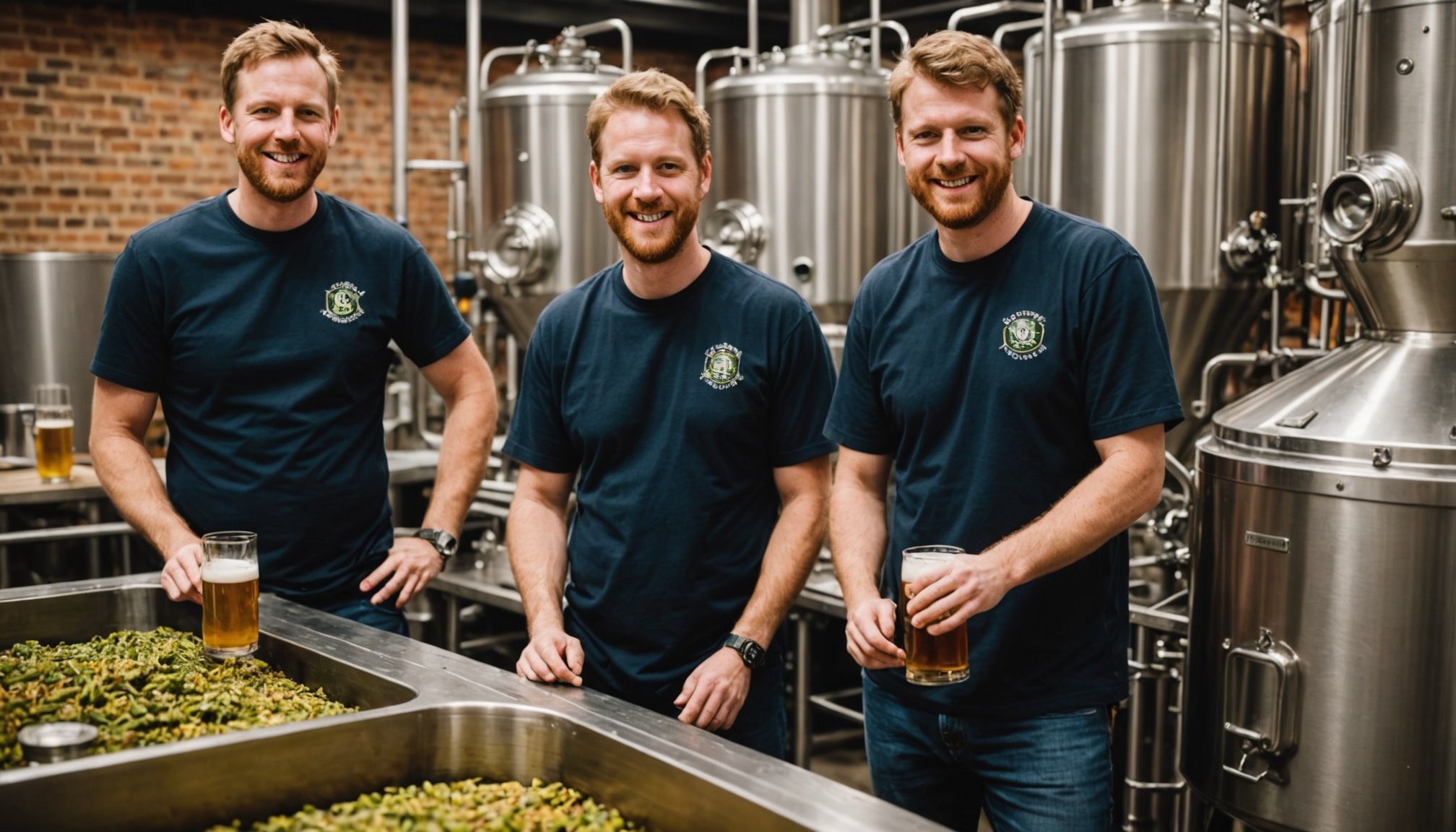Overview of UK Breweries and Local Sourcing
The brewing scene in the UK is undergoing a remarkable transformation, emphasizing craft beer innovation through the use of local ingredients. This shift is driven by a desire to highlight regional flavours and support sustainable practices. UK breweries are increasingly sourcing nearby hops, malt, and other essential components, directly impacting the character and quality of the beers.
One of the key trends in the UK brewing industry is the movement towards local sourcing. Brewers are tapping into regional resources not only to enhance the taste of their beers but also to promote ecological balance and community engagement. The proximity to farming regions allows brewers to access fresh, high-quality ingredients that define the unique flavour profiles of craft beers.
Also to discover : Revolutionizing customer satisfaction: how uk financial institutions use predictive analytics to elevate user experience
The impact of local sourcing on flavor is profound. Ingredients like locally-grown hops contribute to a beer’s aroma and taste, offering a distinctive experience that imported ingredients might not provide. This practice not only helps in reducing the carbon footprint but also establishes trust with consumers who value authenticity and a connection to their locale. Local sourcing thus becomes a crucial part of the craft beer narrative, encouraging brewers to innovate while maintaining a strong bond with their community.
Innovative Brewing Techniques
The world of craft beer is ever-evolving, with breweries across the UK constantly seeking out new brewing techniques to craft the perfect pint. In pursuit of distinct flavours, many breweries have embraced innovative methods that enhance both the process and the finished product.
In the same genre : Unlocking success with a top recruitment marketplace
One noteworthy technique involves utilising indigenous ingredients. By sourcing local ingredients, breweries are not only reducing their carbon footprint but also creating unique flavour profiles that cannot be replicated elsewhere. For example, a brewery in Cornwall might use coastal herbs, while one in Scotland might incorporate wild heather, creating a strong sense of place in every sip.
Technology plays a crucial role in these advancements. Automated brewing systems and precision equipment ensure a consistent product, while digital monitoring allows brewers to tweak processes like temperature and fermentation in real time. These technological enhancements not only improve efficiency but also allow for greater experimentation and refinement in the craft beer methods.
Case studies from some of the UK’s most successful craft breweries reveal how blending traditional techniques with modern technology yields spectacular results. By embracing both historical brewing wisdom and cutting-edge innovations, these brewers are crafting beers that are not only delicious but also reflect the locality and creativity of their makers.
Regional Ingredient Profiles
Delving into the world of regional ingredients unveils a rich tapestry of flavours unique to the UK’s diverse landscape. Regions such as Kent, known for its unparalleled hops, or the barley-rich lands of East Anglia, offer distinctive flavour profiles to brewers who utilise local produce. Such ingredients do not just contribute to taste but also celebrate the heritage of each area.
The impact of seasonal ingredients is notable. While spring may bring forward vibrant and fresh notes, autumn lends a richer, deeper flavour, reflective of the season’s bounty. Beers brewed in the UK often embrace these changes, offering an evolving palette that caters to varied tastes throughout the year.
Sourcing from local farms provides myriad benefits, not only for brewers but for the community too. By focusing on UK agriculture, brewers support local economies, reduce carbon footprints, and connect directly with the source of their ingredients. This practice fosters innovation, allowing the development of new strains and types of brewing components tailored to specific needs.
Incorporating regional ingredients thus becomes a method of storytelling—capturing essence, location, and season in a bottle, creating a truly authentic drinking experience.
Case Studies of Notable Breweries
Exploring the landscape of brewing provides insight into how breweries are fostering innovation and success. Noteworthy establishments illustrate how incorporating local sourcing has revolutionized craft beer production.
Brewery A: Local Hops and Barley
In spotlighting Brewery A, a prominent example of leveraging local sourcing, it’s clear that utilising local hops and barley elevates both sustainability and flavour. This brewery case study showcases how the farm-to-bottle approach transforms standard brews into unique, region-specific beverages. The commitment to supporting local farms not only reduces the carbon footprint but also builds community ties, significantly enhancing both the economy and brand loyalty. Brewery A faced challenges, such as variability in crop yields, but overcame them through agile supplier agreements and diversifying their ingredient pool.
Brewery B: Floral Botanicals and Herbs
Moving to Brewery B, innovation shines through its incorporation of floral botanicals and herbs. Embracing local flora offers versatile flavour profiles, providing a distinct aromatic boost to its ales. This use of locally-sourced botanicals reduces import costs and ensures fresher ingredients, enhancing each brew’s authenticity. By collaborating with local foragers, Brewery B has successfully navigated the challenges of inconsistent herb availability.
Brewery C: Fruits from Local Orchards
Lastly, Brewery C exemplifies success with local orchards, utilising fresh fruits to enrich beer palettes. This practice brings natural sweetness and variety to their productions. Though initially confronted with seasonal limitations, innovative freezing technology now allows for year-round production with consistent quality.
Interviews with Brewers
In recent brewer interviews, many craft beer enthusiasts have emphasized the transformative power of using local ingredients. These interviews reveal that opting for region-specific components not only enriches the beer’s flavour profile but also fosters a deeper connection with the community. Brewers have shared personal stories illustrating how local sourcing has invigorated their creative processes. For instance, encountering a unique grain or hop in their locale has often been a spark for innovation, leading to beers that genuinely capture the soul of the area.
Moreover, the commitment to local ingredients aligns seamlessly with broader sustainability practices. Craft beer makers are increasingly focused on reducing their carbon footprint—a task made achievable by minimizing transportation distances and supporting local agriculture. This sustainable sourcing method enhances the quality of the final product while aligning with environmentally conscious values.
Local sourcing also underscores a commitment to authenticity. Each brew offers not just a taste, but an experience—a journey into the heart of the region itself. The stories shared by brewers highlight this impact, revealing a craft that values not only taste and creativity but also locality and sustainability. As the craft beer scene thrives, these insights continue to shape its future, promising tantalising new innovations for beer lovers everywhere.
Recipes Featuring Local Ingredients
Delving into beer recipes enriched with local ingredients can elevate your home brewing experience. Crafting a brew with locally sourced elements is not only rewarding but also enhances the flavour profile of your beverage.
To start, follow this step-by-step guide to incorporate local ingredients effectively:
- Selection: Choose ingredients that are abundantly available in your region. Look for items like local hops, grains, or even honey, depending on what’s in season.
- Preparation: Clean and prepare your chosen ingredients. For hops or grains, ensure they are fresh and pest-free to maintain the quality of your brew.
When enhancing home brews, consider recommendations for ingredients that harmonize well with your base recipe. For instance, local fruits or spices can add a unique twist to your creation.
Experimentation is key. To truly tailor your beer to the seasons, try varying flavors based on seasonal availability. For spring, introduce floral notes with elderflowers or lavender. Autumn could feature robust flavors from pumpkins or apples.
By prioritizing local produce, not only do you support your region’s agriculture, but you also create distinctive, memorable beers that capture the essence of where they were brewed.
The Future of Craft Beer and Local Sourcing
As we look towards the future trends of the craft beer industry, local sourcing continues to gain importance. Brewers are increasingly committed to incorporating sustainable practices in their production processes. This trend aligns with consumer preferences for supporting local economies and reducing carbon footprints. By sourcing ingredients nearby, breweries are not only minimising transportation emissions but also contributing to sustainability efforts within their communities.
The craft beer landscape is witnessing an evolution wherein sustainability takes a pivotal role. It’s not just about the taste anymore; the origin of ingredients and the methods of production are equally significant to discerning consumers. This shift is driving numerous breweries to innovate their sourcing strategies, ensuring that their practices are environmentally friendly and community-supportive.
In response to these consumer trends, breweries are cultivating relationships with local farmers to secure a steady supply of high-quality ingredients. This connection benefits both parties, fostering a collaborative community spirit and offering unique, fresh flavours that stand out in a saturated market.
Furthermore, as awareness rises around the importance of sustainability, consumers are more likely to choose beers from environmentally conscious brands. The emphasis on locally sourced beers is more than a trend; it’s a movement towards a more sustainable and vibrant craft beer culture.










